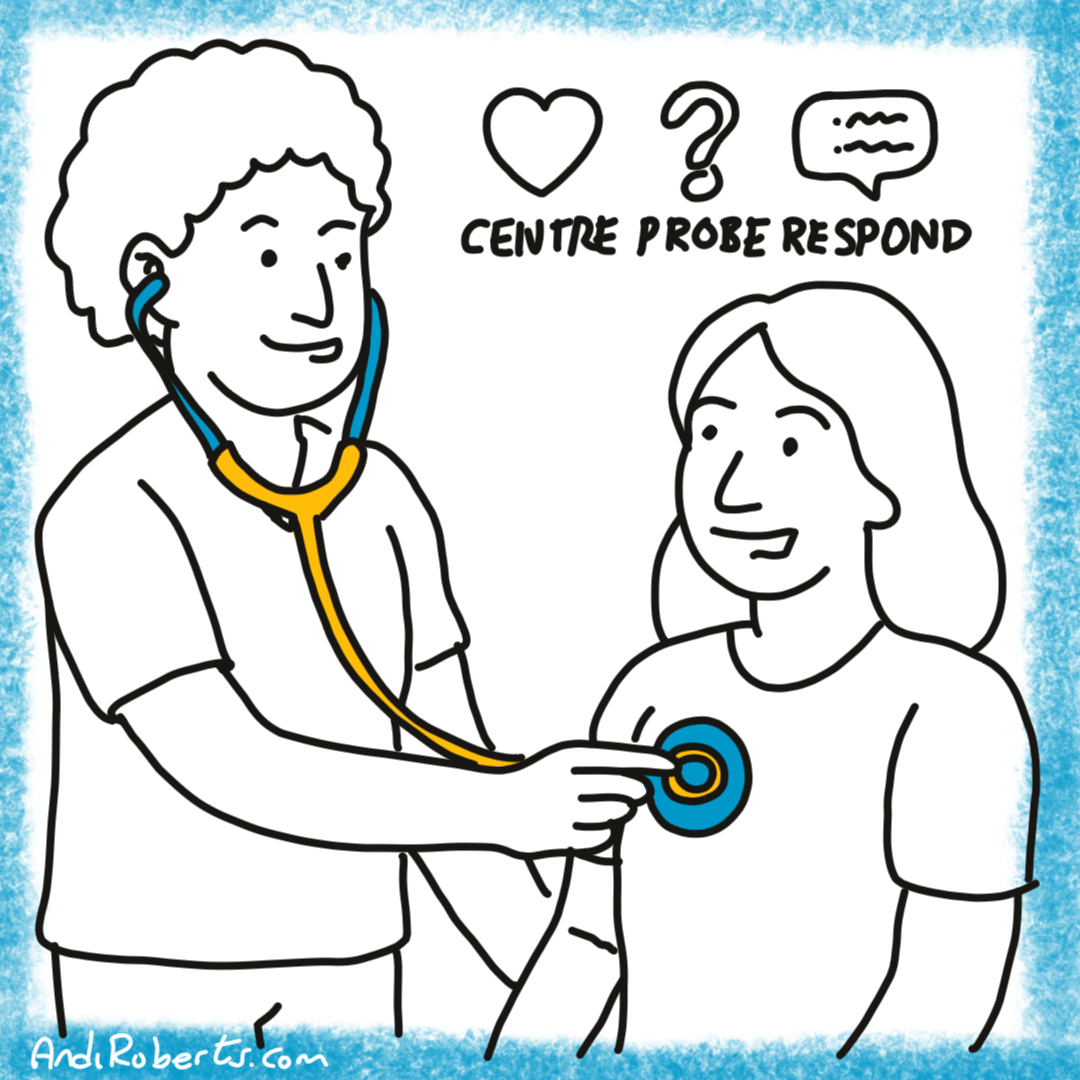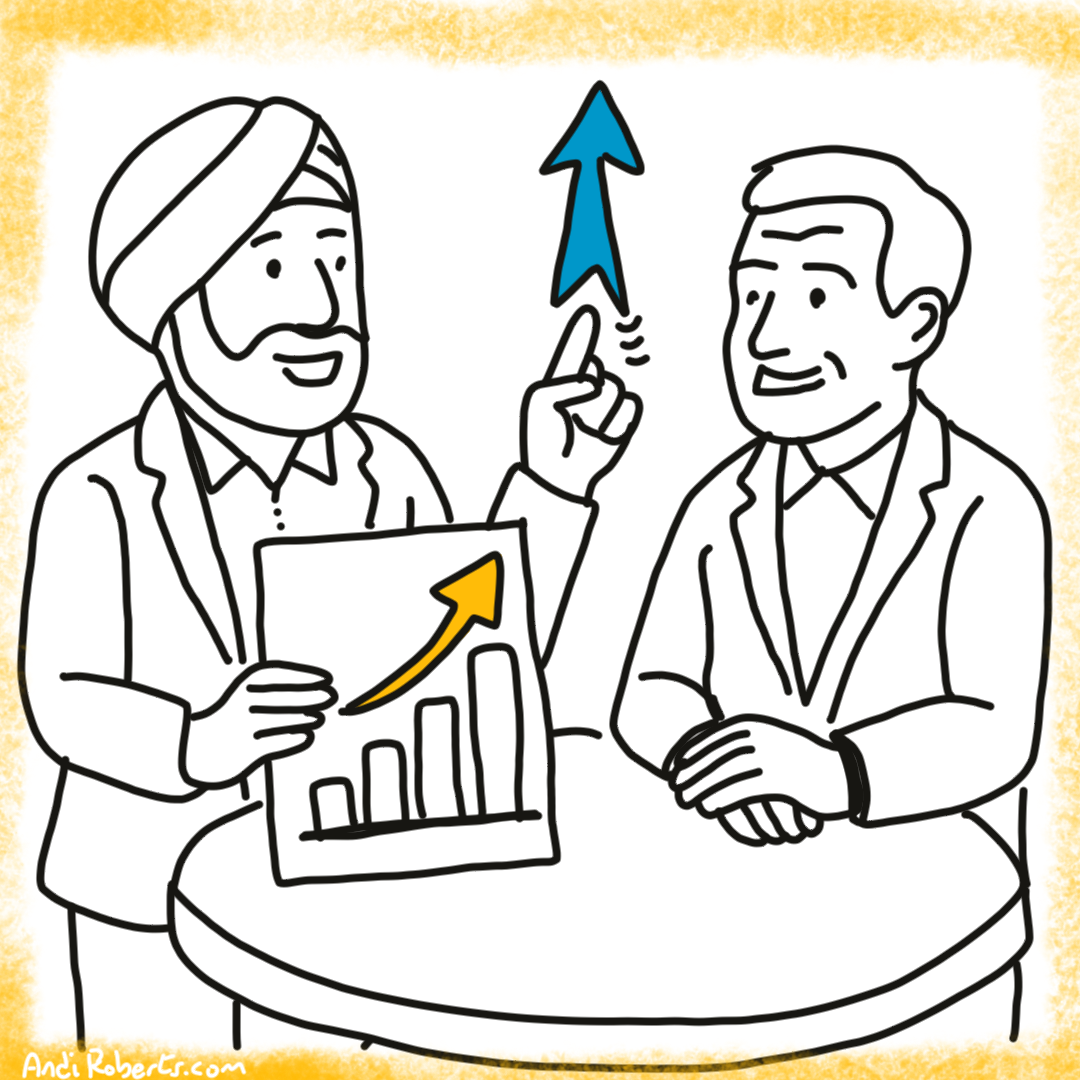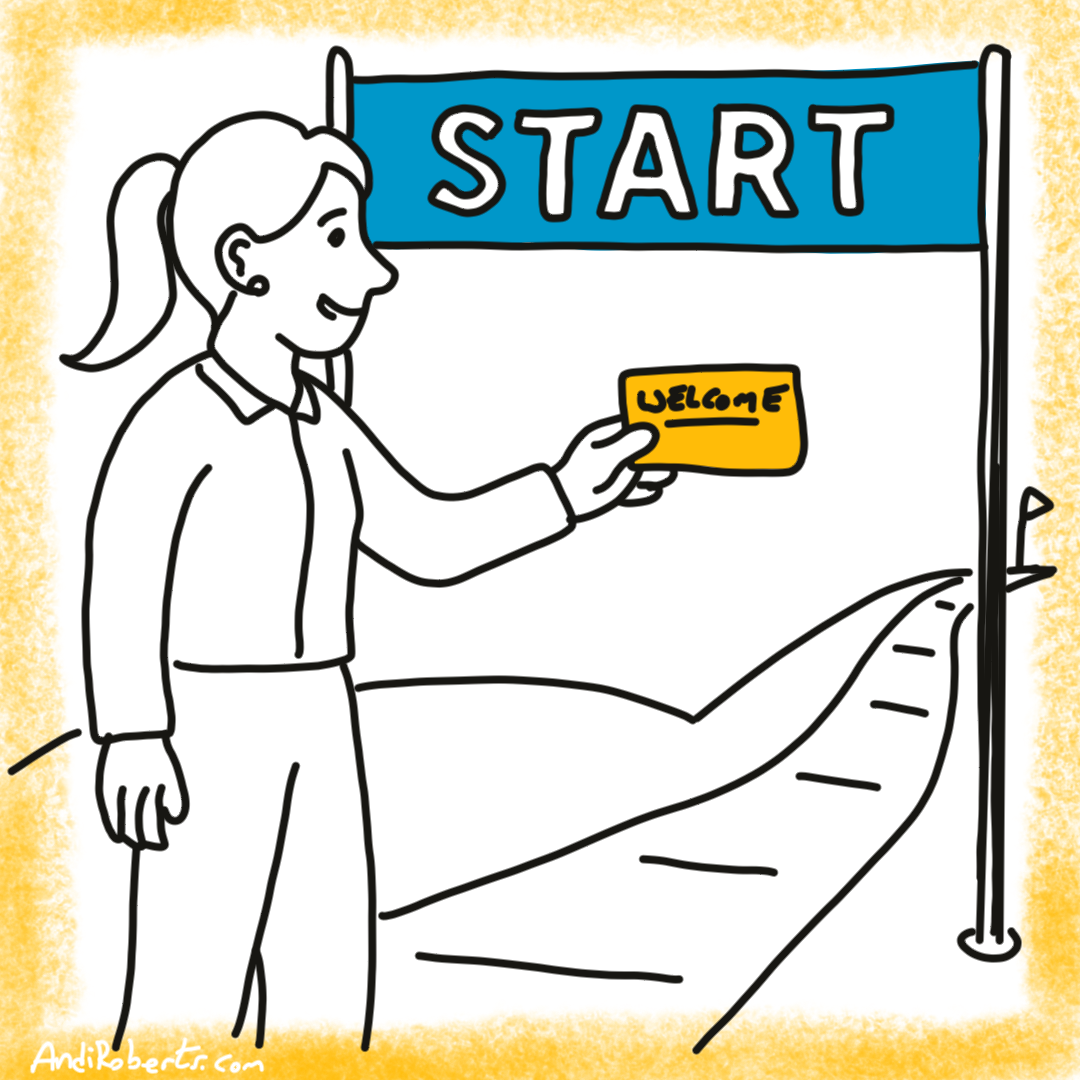How can I stay calm under pressure? It is a question every leader faces, often in the moments when composure feels most out of reach. Pressure arrives in many forms: a meeting that turns tense, an unexpected demand, a decision that carries weight. Our instinct is to speed up, to defend, to act. Yet the faster we move, the less we see.
Neuroscience research shows that acute stress can suppress activity in the prefrontal cortex by up to 70%, reducing our capacity for reasoning, empathy and impulse control (Arnsten, 2009). Under these conditions, even experienced leaders are more likely to make reactive, short-term decisions. Stress narrows perception precisely when perspective is most needed.
The practice of Stop, Breathe, Refocus, Choose offers a way to interrupt that rush. It is not about staying serene or pretending stress does not exist. It is about regaining choice in the moments when emotion and urgency threaten to take it from us.
The four steps to return to calm
1. Stop: Interrupting the automatic
The first step, Stop, interrupts the body’s automatic response to threat. When stress rises, the amygdala floods the body with cortisol and adrenaline, preparing for fight, flight or freeze. This reaction happens in milliseconds, long before the rational brain can intervene. Research at the Benson-Henry Institute for Mind-Body Medicine at Harvard shows that intentionally pausing, even for a few seconds, activates the parasympathetic nervous system and reduces physiological arousal (Benson and Proctor, 2010).
Stopping is not hesitation; it is leadership composure. It means creating a small gap before speaking, sending, or deciding. In that gap, you move from being caught in events to observing them. The act of naming what is happening, such as “I am tense,” or “I feel cornered,” reduces the emotional charge. Neuroscientists have demonstrated that labelling emotions engages the prefrontal cortex and calms the amygdala, restoring capacity for reflection (Lieberman et al., 2007).
A leader who stops before reacting signals something powerful to others: that speed is not the same as strength. In cultures that reward instant answers, the ability to pause can redefine what authority looks like.
Practice
-
Notice physical signs of escalation, such as a racing pulse, tight shoulders, or shallow breath.
-
Name the moment rather than the person or problem: “This is tension,” or “This is uncertainty.”
-
Count to ten before responding, allowing your physiology to stabilise.
Reflect
-
What stories drive your need to respond immediately?
-
How might slowing down in a moment of pressure create confidence rather than doubt?
2. Breathe: Reclaiming the body
Breath is the simplest and most immediate tool for emotional regulation. It is also one of the most neglected. Most of us breathe shallowly when anxious, which keeps the body in a state of mild alarm. Research from Stanford University demonstrates that extending the exhalation, even slightly, activates the vagus nerve and lowers heart rate, creating a sense of safety (Huberman et al., 2020).
Breathing is not about relaxation for its own sake; it is about restoring access to judgment. Studies show that slow, deliberate breathing improves situational awareness and reduces impulsive reactions under stress (Kossek and Perrigino, 2016). By returning to the body, leaders also return to the present. A steady breath communicates composure more effectively than any words.
This step matters because pressure disconnects us from our physical selves. By breathing with attention, you remind both body and mind that you are safe enough to think clearly again.
Practice
-
Try a 4–6 rhythm: inhale through the nose for four counts and exhale through the mouth for six.
-
Let the shoulders drop as you exhale; notice how your field of attention widens.
-
In meetings, take one visible breath before responding to challenge or conflict.
Reflect
-
What is your natural breathing pattern when under stress?
-
How might your presence change if you used breath as a leadership reset?
3. Refocus: Facing what is true
Stopping and breathing create the conditions for refocusing. This third step is the bridge between reaction and intention. It invites four core questions:
-
What is the truth here?
-
What is my goal?
-
What are my resources, inner and outer?
- What are my choices?
Refocusing works because stress distorts perception. Kahneman (2011) showed that under pressure the brain defaults to rapid, emotional processing. To regain balance, we need to slow down and see clearly. Research on cognitive reappraisal demonstrates that distinguishing between facts and interpretations reduces emotional intensity and improves problem solving (Gross and John, 2003). Writing down what is verifiably true and what is assumed helps leaders separate data from story.
The second question, “What is my goal?”, returns attention to purpose. Pressure often shifts focus from outcomes to reactions. Reconnecting with what truly matters redirects energy toward constructive action.
The third question, “What are my resources?”, restores perspective. Support, both internal and external, strengthens resilience. A major review of workplace resilience found that perceived support from colleagues and mentors significantly improves adaptability and wellbeing (Kossek and Perrigino, 2016).
The fourth question, “What are my choices?”, transforms awareness into agency. Under stress, options can seem to disappear. By consciously identifying choices, even small ones, leaders reclaim their sense of influence and responsibility. Naming choices aloud turns possibility into action and reduces the feeling of being trapped by circumstance.
Refocusing is not about forced optimism. It is about clarity, seeing things as they are, not worse than they are.
Practice
-
Make a quick list with three columns for FOG: Fact, Opinion and Guess (supposition)
-
Re-state your purpose in one sentence beginning with “I want to…”
-
Identify one personal strength and one person who can help you think.
Reflect
-
What truths do you find hardest to name in moments of tension?
-
Who helps you regain perspective when the picture feels distorted?
4. Choose: Acting with intention
Choice is the culmination of the practice. It turns clarity into movement. After stopping, breathing, and refocusing, you are ready to choose with intention.
Under stress, leaders often default to control. Yet research on decision-making under acute stress shows that cortisol narrows attention and increases either risk-taking or avoidance (Porcelli and Delgado, 2009). Deliberate choice counteracts this by widening perspective and re-engaging the reasoning centres of the brain.
Three questions guide this step:
-
What choice aligns most closely with who I want to be as a leader?
-
Every decision is a small act of self-definition. When pressure mounts, it is easy to choose expedience over integrity. Returning to who you want to be shifts the frame from outcome to identity. This question links the immediate situation to your longer-term character and helps decisions express consistency between values and behaviour.
-
How will this decision affect others, both now and later?
-
Stress tends to narrow empathy. Considering others before acting reactivates the social brain and widens the lens of responsibility. Research shows that taking others’ perspectives before making a decision strengthens moral reasoning and fosters trust (Waytz, Dungan and Young, 2014). This question moves choice from self-protection to stewardship.
-
What would I decide if I were calm, not fearful?
-
Fear is often the unseen driver of reaction. By naming it, you reduce its power. Imagining the decision from a calmer state helps bypass the short-term urgency produced by the stress response and reconnects thinking with reason and empathy. This question restores agency by reminding you that composure can be chosen, not waited for.
Considering others before acting activates empathy networks in the brain and supports ethical decision-making (Waytz, Dungan and Young, 2014). Choosing through the lens of values rather than fear builds trust, both internally and externally.
Psychologist Albert Bandura argued that agency, the belief in one’s ability to influence events, is a cornerstone of human motivation and wellbeing (Bandura, 2001). Every conscious choice reinforces that agency. Even in the most constrained situations, leaders retain the freedom to decide how they will respond.
Practice
-
Before acting, name the value you want the decision to reflect, such as fairness, courage, or respect.
-
Consider how the choice might look one month or one year from now.
-
Communicate your decision clearly, explaining the reasoning without defensiveness.
Reflect
-
Which of your recent decisions were reactions rather than choices?
-
How do your values show up when the pressure is highest?
From personal discipline to leadership practice
The four-beat rhythm of Stop, Breathe, Refocus, Choose begins as a personal discipline, yet its greatest power appears when it becomes a shared way of leading. Leaders who practise composure consistently influence not only their own choices but also the emotional climate of those around them. Research on emotional contagion shows that people unconsciously absorb the moods of those in authority (Hatfield, Cacioppo and Rapson, 1994). Calm, it turns out, is communicable.
Bringing this rhythm into daily leadership does not require grand gestures. A short pause before a meeting signals that presence matters more than pace. A single breath before responding in conflict shows that pressure does not have to define behaviour. Asking “What is true here?” before acting creates space for reflection and respect. Small acts like these give permission for thoughtfulness, even amid urgency.
With practice, Stop, Breathe, Refocus, Choose becomes more than a personal coping tool. It shapes how teams speak, decide and recover. When leaders model calm, psychological safety grows. Conversations shift from defence to curiosity, and decisions take into account both consequence and connection. Over time, the organisation begins to mirror the steadiness of its leaders.
This is what stewardship in practice looks like: the capacity to stay grounded while everything else accelerates. Stop, Breathe, Refocus, Choose teaches that composure is not control but freedom. It is the freedom to think clearly, act with integrity, and meet uncertainty without losing self. A leader who can pause in the heat of pressure gives others permission to do the same. In that moment, calm becomes cultural, not personal, and the quiet authority of presence changes the room more than any plan or performance ever could.
Three Questions for Reflection
-
When pressure rises, what do you instinctively reach for: control, speed, or understanding?
-
How might your leadership change if calm were not a personal mood but a signal you offer to others?
-
In the situation that challenges you most right now, what would it mean to Stop, Breathe, Refocus, and Choose?
Do you have any tips or advice for dealing with pressure or stress in the moment or strategies for creating inner and outer calmness?
What has worked for you?
Do you have any recommended resources to explore?
Thanks for reading!
References
Arnsten, A. F. T. (2009) ‘Stress signalling pathways that impair prefrontal cortex structure and function’, Nature Reviews Neuroscience, 10(6), pp. 410–422.
Bandura, A. (2001) ‘Social cognitive theory: An agentic perspective’, Annual Review of Psychology, 52(1), pp. 1–26.
Benson, H. and Proctor, W. (2010) Relaxation Revolution: The Science and Genetics of Mind Body Healing. New York: Scribner.
Gross, J.J. and John, O.P. (2003) ‘Individual differences in two emotion regulation processes: Implications for affect, relationships, and well-being’, Journal of Personality and Social Psychology, 85(2), pp. 348–362.
Hatfield, E., Cacioppo, J.T. and Rapson, R.L. (1994) ‘Emotional contagion’, Review of General Psychology, 2(3), pp. 280–307.
Huberman, A.D., Nestor, A. et al. (2020) ‘Breathing control circuits in the brainstem and their influence on emotion and stress’, Cell Reports, 33(5), p. 108544.
Kahneman, D. (2011) Thinking, Fast and Slow. New York: Farrar, Straus and Giroux.
Kossek, E.E. and Perrigino, M.B. (2016) ‘Resilience in the workplace: How to build it and sustain it’, Academy of Management Annals, 10(1), pp. 729–797.
Lieberman, M.D., Eisenberger, N.I., Crockett, M.J., Tom, S.M., Pfeifer, J.H. and Way, B.M. (2007) ‘Putting feelings into words: Affect labeling disrupts amygdala activity in response to affective stimuli’, Psychological Science, 18(5), pp. 421–428.
Porcelli, A.J. and Delgado, M.R. (2009) ‘Acute stress modulates risk taking in financial decision making’, Proceedings of the National Academy of Sciences, 106(23), pp. 9128–9133.
Waytz, A., Dungan, J. and Young, L. (2014) ‘The whistleblower’s dilemma and moral judgment under social connection’, Organizational Behavior and Human Decision Processes, 123(2), pp. 14–26.





Leave A Comment